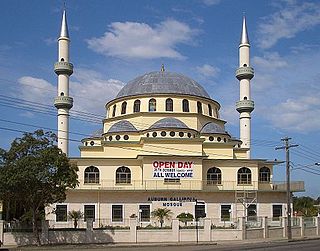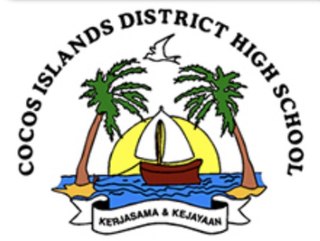
The Cocos (Keeling) Islands, officially the Territory of Cocos (Keeling) Islands, are an Australian external territory in the Indian Ocean, comprising a small archipelago approximately midway between Australia and Sri Lanka and relatively close to the Indonesian island of Sumatra. The territory's dual name reflects that the islands have historically been known as either the Cocos Islands or the Keeling Islands.
Demographic features of the population of the Cocos (Keeling) Islands include population density, ethnicity, education level, health of the populace, economic status, religious affiliations and other aspects of the population.

Islam is a minority faith in Thailand, with statistics suggesting 4.9% of the population are Muslim. Figures as high as 5% of Thailand's population have also been mentioned. A 2023 Pew Research Center survey gave 7%. Thai Muslims are the largest religious minority in the country.

Islam is the third largest religion in Sri Lanka, with about 9.7 percent of the total population following the religion. About 1.9 million Sri Lankans adhere to Islam as per the Sri Lanka census of 2012. The majority of Muslims in Sri Lanka are concentrated in the Eastern Province of the island. Other areas containing significant Muslim minorities include the Western, Northwestern, North Central, Central and Sabaragamuwa provinces. Muslims form a large segment of the urban population of Sri Lanka and are mostly concentrated in major cities and large towns in Sri Lanka, for example Colombo. Most Sri Lankan Muslims primarily speak Tamil language, though it is not uncommon for Sri Lankan Muslims to be fluent in Sinhalese. The Sri Lankan Malays speak the Sri Lanka Malay language in addition to Sinhalese and Tamil.

Cocos (Keeling) Islands Airport is an airport serving the Cocos (Keeling) Islands, a territory of Australia located in the Indian Ocean. The airport is on West Island, one of the South Keeling Islands and capital of the territory.

Cocos Malays are a community that form the predominant group of the Cocos (Keeling) Islands, which is now a part of Australia. Today, most of the Cocos Malay can be found in the eastern coast of Sabah, Malaysia, because of diaspora originating from the 1950s during the British colonial period.

West Island, part of the South Keeling Islands, is the capital of the Cocos (Keeling) Islands, an Australian external territory in the Indian Ocean. The population is roughly 120, making it the third smallest capital in the world, and consists mainly of Europeans. It is less populous than Home Island, the only other inhabited island.
Malaysian Australians refers to Malaysians who have migrated to Australia or Australian-born citizens who are of Malaysian descent. This may include Malaysian Chinese, Malays, Malaysian Indians, Orang Asal, mixed Malaysians and other groups.

North Keeling is a small, uninhabited coral atoll, approximately 1.2 square kilometres (0.46 sq mi) in area, about 25 kilometres (16 mi) north of Horsburgh Island. It is the northernmost atoll and island of the Australian territory of the Cocos (Keeling) Islands. It consists of just one C-shaped island, a nearly closed atoll ring with a small opening into the lagoon, about 50 metres (160 ft) wide, on the east side. The lagoon is about 0.5 square kilometres (0.19 sq mi) in area. The island is home to the only surviving population of the endemic, and endangered, Cocos buff-banded rail, as well as large breeding colonies of seabirds. Since 1995, North Keeling Island and the surrounding sea to 1.5 kilometres (0.93 mi) from shore have been within the Pulu Keeling National Park.

Islam in Oceania refers to Islam and Muslims in Oceania. By current estimates, there are 620,156 total Muslims in Oceania: 476,600 in Australia, 48,151 in New Zealand, 52,520 in Fiji, 6,352 in New Caledonia, 2,200 in Papua New Guinea, 360 in Solomon Islands, 221 in Vanuatu, 110 in Tonga.

Home Island, also known locally as Pulu Selma, is one of only two permanently inhabited islands of the 26 islands of the Southern Atoll of the Cocos (Keeling) Islands, an Australian external territory in the central-eastern Indian Ocean.

Sri Lankan Malays are Sri Lankan citizens with full or partial ancestry from the Indonesian Archipelago, Malaysia, or Singapore. In addition, people from Brunei and the Philippines also consider themselves Malays. The term is a misnomer as it is used as a historical catch-all term for all native ethnic groups of the Malay Archipelago who reside in Sri Lanka; the term does not apply solely to the ethnic Malays. They number approximately 40,000 and make up 0.2% of the Sri Lankan population, making them the fourth largest of the five main ethnic groups in the country.
Singaporean Australians are Australians of Singaporean descent. As Singapore is a multi-racial country, a Singaporean Australian could either be of Chinese, Malay or Indian descent, the main races of Singapore. According to the 2006 Australian census, 39,969 Australians were born in Singapore while 4,626 claimed Singaporean ancestry, either alone or with another ancestry.

Although it is an Australian External Territory, the culture of the Cocos (Keeling) Islands has extensive influences from Malaysia and Indonesia.

Cocos Islands District High School is the school of the Cocos (Keeling) Islands, Australia. The West Island campus serves grades K–10 with separate primary and secondary wings while the Home Island campus serves grades K–6.
The West Island Mosque is a heritage-listed mosque at Alexander Street, West Island, of the Cocos (Keeling) Islands, an external territory of Australia. The mosque was added to the Australian Commonwealth Heritage List on 22 June 2004.

The Home Island Cemetery is a heritage-listed cemetery at Home Island, Cocos (Keeling) Islands, Australia. It was added to the Australian Commonwealth Heritage List on 22 June 2004.
The South Keeling Islands are a group of islands of the Cocos (Keeling) Islands, next to North Keeling, about 27 km (17 mi) to the north. The Australian atoll is located in the Indian Ocean about 2,930 km (1,821 mi) northwest of Perth, 3,685 km (2,290 mi) west of Darwin, 960 km (597 mi) southwest of Christmas Island and more than 1,000 km (621 mi) southwest of Java and Sumatra.

The Javanese diaspora is the demographic group of descendants of ethnic Javanese who emigrated from the Indonesian island of Java to other parts of the world. The Javanese diaspora includes a significant population in Suriname, with over 13% of the country's population being of Javanese ancestry. Other major enclaves are found in Australia, French Guiana, Malaysia, the Netherlands, New Caledonia, Singapore, South Africa, and Sri Lanka.














